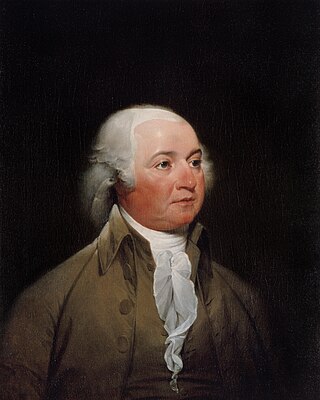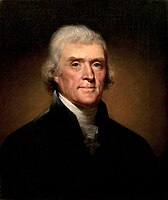
The Twelfth Amendment to the United States Constitution provides the procedure for electing the president and vice president. It replaced the procedure in Article II, Section 1, Clause 3, under which the Electoral College originally functioned. The amendment was proposed by Congress on December 9, 1803, and was ratified by the requisite three-fourths of state legislatures on June 15, 1804. The new rules took effect for the 1804 presidential election and have governed all subsequent presidential elections.

The 1796 United States presidential election was the third quadrennial presidential election of the United States. It was held from Friday, November 4 to Wednesday, December 7, 1796. It was the first contested American presidential election, the first presidential election in which political parties played a dominant role, and the only presidential election in which a president and vice president were elected from opposing tickets. Incumbent vice president John Adams of the Federalist Party defeated former secretary of state Thomas Jefferson of the Democratic-Republican Party.

The 1800 United States presidential election was the fourth quadrennial presidential election. It was held from October 31 to December 3, 1800. In what is sometimes called the "Revolution of 1800", the Democratic-Republican Party candidate, Vice President Thomas Jefferson, defeated the Federalist Party candidate, incumbent president John Adams. The election was a political realignment that ushered in a generation of Democratic-Republican leadership. This was the first presidential election in American history to be a rematch.

The 1804 United States presidential election was the fifth quadrennial presidential election, held from Friday, November 2, to Wednesday, December 5, 1804. Incumbent Democratic-Republican president Thomas Jefferson defeated Federalist Charles Cotesworth Pinckney of South Carolina. It was the first presidential election conducted following the ratification of the Twelfth Amendment to the United States Constitution, which reformed procedures for electing presidents and vice presidents.

In the United States, the Electoral College is the group of presidential electors required by the Constitution to form every 4 years for the sole purpose of appointing the president and vice president. Each state appoints electors under the methods described by its legislature, equal in number to its congressional delegation. The federal District of Columbia also has 3 electors under an amendment adopted in 1961. Federal office holders, including senators and representatives, cannot be electors. Of the current 538 electors, an simple majority of 270 or more electoral votes is required to elect the president and vice president. If no candidate achieves a majority there, a contingent election is held by the House of Representatives to elect the president and by the Senate to elect the vice president.

The election of the president and the vice president of the United States is an indirect election in which citizens of the United States who are registered to vote in one of the fifty U.S. states or in Washington, D.C., cast ballots not directly for those offices, but instead for members of the Electoral College. These electors then cast direct votes, known as electoral votes, for president, and for vice president. The candidate who receives an absolute majority of electoral votes is then elected to that office. If no candidate receives an absolute majority of the votes for president, the House of Representatives elects the president; likewise if no one receives an absolute majority of the votes for vice president, then the Senate elects the vice president.

The 1800 United States presidential election in Pennsylvania took place on December 1, 1800 during a special session of the Pennsylvania General Assembly. Members of the bicameral state legislature chose 15 electors to represent Pennsylvania in the Electoral College as part of the 1800 United States presidential election. Eight Democratic-Republican electors and seven Federalist electors were selected. Unlike in the previous election, when one elector split his ballot between Republican Thomas Jefferson and Federalist Thomas Pinckney, all 15 electors followed the party line, with the Republicans voting for Jefferson and the Federalists for incumbent President John Adams. This was the first and only U.S. presidential election in which Pennsylvania's electors were not chosen by popular vote.

The 1800 United States elections elected the members of the 7th United States Congress. The election took place during the First Party System, and is generally considered the first realigning election in American history. It was the first peaceful transfer of power between parties in American history. The Democratic-Republican Party won control of the Presidency and both houses of Congress for the first time. Conversely, the Federalist Party would never again control the Presidency or either house of Congress. Ohio was admitted as a state during the 7th Congress.
In the United States, a contingent election is used to elect the president or vice president if no candidate receives a majority of the whole number of Electors appointed. A presidential contingent election is decided by a special vote of the United States House of Representatives, while a vice-presidential contingent election is decided by a vote of the United States Senate. During a contingent election in the House, each state delegation votes en bloc to choose the president instead of representatives voting individually. Senators, by contrast, cast votes individually for vice president.

The 1800 United States presidential election in Vermont took place between October 31 and December 3, 1800, as part of the 1800 United States presidential election. The state legislature chose four representatives, or electors to the Electoral College, who voted for President and Vice President.

The 1800 United States presidential election in Connecticut took place between October 31 and December 3, 1800, as part of the 1800 United States presidential election. The state legislature chose nine representatives, or electors, to the Electoral College, who voted for President and Vice President.

The 1800 United States presidential election in New Jersey took place between October 31 and December 3, 1800, as part of the 1800 United States presidential election. The state legislature chose seven representatives, or electors to the Electoral College, who voted for President and Vice President.

The 1816 United States presidential election in Indiana took place between November 1 to December 4, 1816, as part of the 1816 United States presidential election. The state legislature chose three representatives, or electors to the Electoral College, who voted for President and Vice President.

The 1800 United States presidential election in Rhode Island took place as part of the 1800 United States presidential election. Voters chose 4 representatives, or electors to the Electoral College who voted for president and vice president.

Electoral history of John Adams, who served as the second president of the United States (1797–1801) and the first vice president of the United States (1789–1797). Prior to being president, he had diplomatic experience as the second United States envoy to France (1777–1779), the first United States minister to the Netherlands (1782–1788), and the first United States minister to the United Kingdom (1785–1788). After losing the 1800 presidential election to Thomas Jefferson, he would mostly retire from political life, with his second youngest son, John Quincy Adams (1767–1848), being elected as the sixth President of the United States (1825–1829) in the 1824 presidential election against Tennessee Senator Andrew Jackson.

The 1800 United States presidential election in Maryland took place on an unknown date in 1800, as part of the 1800 presidential election. Voters chose ten representatives, or electors to the Electoral College, who voted for President and Vice President.
















